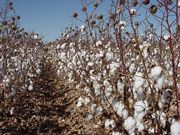7 Little Known Facts About Arizona Agriculture's Cotton
Published
5/20/2013
By Julie Murphree, Arizona Farm Bureau: As you slip your favorite pair of comfortable jeans on, you probably, like most of us, take them for granted. A good pair of jeans is a must in our mix of clothes.
Have you ever thought about the cotton that it takes to make those favorite jeans? Most of us take our cotton jeans, shirts and other unmentionables for granted too. Arizona agriculture grows some of the best cotton around. And, did you know that Arizona Farmers produce enough cotton in a year to provide us all in America with one pair of jeans each (for every man,

So, that leads me to wonder what else we take for granted about cotton? I mean, other than the stereotypical image of white fluffy cotton fields, what do most Americans know about cotton?
In my quest to learn more about cotton, here are seven
- Cotton seeds are tough enough to survive travel across oceans on the wind. This could explain how botanists are not sure where the first cotton plants came from, and probably why similar varieties grow sometimes thousands of miles apart. But it does explain why the Hohokam Indian tribe was growing it thousands of years ago here in the southwest.
- Even though cotton is over 5,000 years old, the people who grew and used it never came in contact with each other. Some of them even lived on different sides of an ocean, but astonishingly enough, they still managed to develop similar tools to clean, prepare, spin, and weave it.
- Despite its well-earned reputation
of casual comfort, the actual word "cotton" is an English version of the Arabic "qutun " or "kutun ," a generic term meaning fancy fabric. One of cotton's original popular names was "vegetable wool." - The American South owes its success in the peanut growing industry to cotton---sort of. The boll weevil created an economic crisis all over the American South by laying its eggs in the cotton bolls, destroying much of the crops in the process. Enterprise, Alabama cotton farmers watched this helplessly until someone suggested they try growing peanuts instead, which is now one of their most successful crop products! In the meantime, a boll weevil eradication program has nearly wiped out the little pest.
- Cotton was originally not only grown in
white, but assorted other colors including brown, rust and light purple. When mechanical processing methods (think the Industrial Age)were introduced it was easier to maintain color consistency by using only white-fibered plants. - Arizona cotton, along with California cotton, is some of the whitest, highest-quality cotton around. One main reason is that Arizona and California irrigate the cotton. With so little rainfall in the southwest, the cotton fiber is not at risk for compromised quality due to wind and rain.
- One of the finest extra-long staple (ELS)
cottons was developed and grown right here in Arizona. The USDA in Sacaton, Arizona, had an ELS breeding program that helped develop the ELS cotton.
In Eloy, Arizona, The Cotton Shedd, run by Rodney and Tiffany Shedd, is a working farm that produces not only
So, the next time you pull on those favorite pair of comfortable jeans, just keep in mind that the cotton makes your jeans comfortable. And Arizona farmers worked hard to produce them.